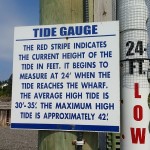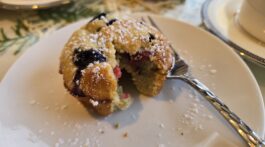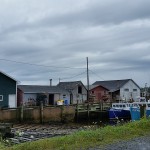Lobsters are an essential part of my summer. It’s incomplete unless I wrestle with a whole lobster on the dock at SoNo Seaport. I also like to grab some ready-made lobster rolls at Stews. Lobster ravioli, lobster linguine, lobster mac and cheese, and other chef-created lobster dishes, tempt me on local menus all season long.
Lobsters used to be harvested locally. Colorful floats marking lobster pots were a common sight around Norwalk harbor, up and down Long Island Sound, and along the length of the New England Coast. Sadly, our local waters no longer support a lobster fishery. Some suggest that the lobsters don’t like the warming waters of southern New England, but no one knows for sure why their habits are changing.
An article in The Hour on August 18 pointed out that even though lobsters are scarce here, the harvest up north is bigger than ever. Area fish counters are selling them at bargain prices. Chefs are including lobster all across their menus. Seafood shacks are encouraging you to dig in.
We’ve just come back from the Canadian Maritimes (Nova Scotia, Cape Breton Island, Prince Edward Island and New Brunswick) where the lobster industry is flourishing. The Maritimes all have a long seafaring tradition including a thriving lobster fishery. Anywhere along the long and rugged coast where there is a sheltering harbour (yes they spell it with a U) to dock a boat, you’ll find lobstermen with their work-horse boats, stacks of traps, and picturesque but functional dockside shacks.
Even with restrictive fishery management practices designed to insure a future harvest, they’re pulling up lobsters like crazy. Each region along the coast has its open and closed seasons for lobstering to prevent over harvesting. There’s not much trapping in any region during August to protect egg-carrying females. Lobster traps are stacked up on the docks or alongside the houses of lobstermen waiting for the season to re-open.
The lobster boats are brightly colored and functional. They’re often named after a family member and prominently display their license numbers. Running 30 to 40 feet long, they have a wide clear deck for working the traps, a small wheelhouse to shelter the crew, and a high bow to fend off steep waves and rough seas. Just like a farmer’s pickup truck – the boats are the basic equipment for a lobstering livelihood. In August they’re mostly at the dock, but you do see a few hauled out for bottom cleaning, painting, or mechanical work.
Even though there is no lobstering at the moment, the evidence of a strong lobster fishing culture is seen everywhere: boats and traps all along the coast; lobster on menus everywhere (you can even get a lobster roll under the golden arches); and truckloads of lobsters heading south to supply the rest of lobster-hungry North America.
Lobsters are always held live in storage until they are ready to be cooked. Tanks that you see in the fish market or grocery store are smaller versions of lobster pounds that keep them live and kicking with circulating seawater. At the Lobster Pound in Hall’s Harbour, NS there were 47,000 pounds of lobsters waiting for shipment on the day we visited, and this is just one of the company’s three locations of similar size.
 At the Hall’s Harbour Lobster Pound and Restaurant you can pick a lobster from a tank organized by size, have it cooked right then, and eat it on the dock while you watch the tide rise and fall. Since Hall’s Harbour is in the upper reaches of the Bay of Fundy, you can actually watch the tide come and go. The twice a day change of around 40 feet from high to low translates to about 6 feet an hour (roughly the entire tide change in Norwalk). You can easily gain or lose a couple feet while your lobster is in the cook shack.
At the Hall’s Harbour Lobster Pound and Restaurant you can pick a lobster from a tank organized by size, have it cooked right then, and eat it on the dock while you watch the tide rise and fall. Since Hall’s Harbour is in the upper reaches of the Bay of Fundy, you can actually watch the tide come and go. The twice a day change of around 40 feet from high to low translates to about 6 feet an hour (roughly the entire tide change in Norwalk). You can easily gain or lose a couple feet while your lobster is in the cook shack.
Lobster isn’t the only fishery in the maritimes. In fact, seafood abounds and is readily available. Haddock has replaced scarce cod as an everyday favorite fish. Its featured in fish and chips as well as broiled, pan fried, stuffed, and in chowder. Draggers bring in sea scallops from the offshore banks. Prince Edward Island is famous for mussels. The floats for the mussel “farms” are visible in coves and harbors all along the coast. PEI is also a rich source for oysters, competing with our local Blue Points. Malpeque Bay is the home of the Malpeque oyster, smaller and slower growing than Norwalk oysters, but intensely flavored.
I’d like to tell you that we had one meal that included all the local seafoods, but we didn’t. We enjoyed them all at one time or another, and there was one dinner that included both oysters and mussels, but we couldn’t get all five at one time. We have our limits.
Good restaurants are found in every corner of the Maritimes. There’s lots of crisp fish and chips and chunky fish chowder, and Lobster dinners, too: on the dock or indoors and even a few all-you-can-eat. We also encountered a broad spectrum of restaurants: excellent owner-operated places, old-line resort dining, a fast food meal (I’m embarrassed to say), and an inn with one of the most creative menus I’ve ever seen. A saturday brunch menu included Lobster and Asparagus Benedict, Lobster Florentine Omelette, Lobster Scramble, and the ever-popular Lobster Roll.
The seafood is all around in the Maritimes with abundant lobsters, haddock from traditional off-shore fisheries, local scallops, farmed mussels. and cultivated oysters. We ate well, and, other than bacon at breakfast, all our meals were from the sea!













No Comment